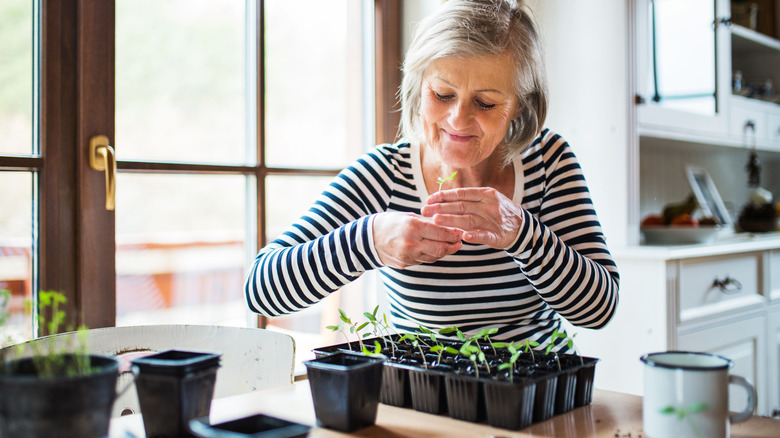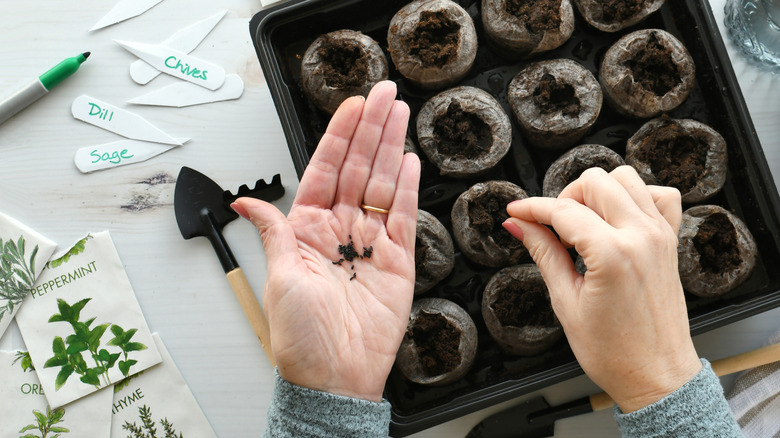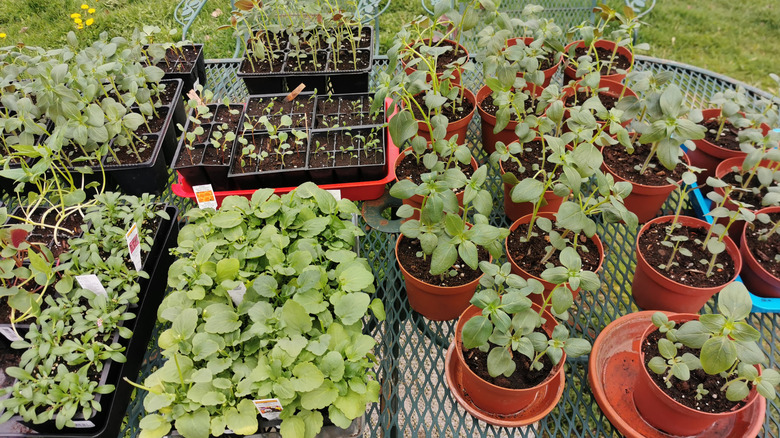Herbs You Can Start Sowing Indoors In Late Winter For A Spring Garden
Winter might seem like the perfect time to take a break after a hard year of gardening, giving you a bit of time to relax as you plan your next harvest. But with spring right around the corner, there are a few plants that might benefit from a head start, specifically herbs. Many species take longer to germinate, and the late winter months provide a small window of opportunity to get them started indoors. Starting seedlings indoors also allows you to control individualized light intake, moisture levels, and temperature, all of which contribute to healthier plant growth. To give your herbs the best chance of survival and optimal growth in the spring, here are a few that can benefit from a bit of indoor planting during the late winter months.
Herbs like parsley, rosemary, and thyme can be tricky to plant outdoors as they both have long germination periods, anywhere between 14 to 28 days. Chives and oregano don't take as long as some herbs to germinate, typically sprouting within 7-21 days, but starting them indoors can produce a well-developed root system that allows them to adjust to your garden. Other herbs that can be started in the late winter include sage, cilantro, and dill. Giving all these seeds a bit of a jumpstart in the winter can ensure that you have a successful harvest when planting the rest of your garden.
Tips for starting seeds indoors
Growing herbs indoors during winter often requires the right setup to ensure healthy germination and early growth. Most herbs thrive in fairly warm soil that remains consistently moist, but not completely soaked. Your seedlings should be kept in a climate-controlled area of your home, whether it's an insulated garage or a small corner of your kitchen. Once you're ready to start planting, grab yourself a few seed starting trays, either from a garden center or transform old food containers into simple DIY seed starters.
Moisten the soil in a bowl before dividing it into your trays. Plant the herb seeds into the soil, labelling them as you continue. Oregano, sage, thyme, and dill need light to germinate, so place these seeds on top of the soil. Meanwhile, parsley, cilantro, and chives germinate better in a dark environment, so cover these seeds with the medium. Finally, water the soil from the bottom of the tray and cover the container to trap moisture.
Lighting is a vital requirement for seedlings once they sprout. As winter days are shorter, your plants will not have access to the same amount of sunlight as they would in other seasons. This means that you will need to provide them with an artificial source of light, like a grow light. There are plenty of excellent grow lights for indoor plants, and you'll find them at just about any garden center. To prevent your seedlings from becoming weak or leggy, you should keep your grow lights on for about 12 to 14 hours per day.
Harden off the seedlings before transplanting them outdoors
With the quick arrival of spring, your small seedlings are just about ready to go into the ground, becoming a welcome addition to your garden. But you can't simply plant them after a few months of being indoors, as too much direct sunlight and drastic temperature changes can easily give your garden seedlings transplant shock. Instead, you need to harden off your plants, slowly introducing them to outdoor conditions, starting about 14 days before you plan to plant them in the ground. On the first day the outdoor temperature climbs above 45 degrees Fahrenheit, give your plants an hour of shaded outdoor time. Bring them back indoors and store them in a heated area of your home. Each day, increase the amount of time that your young plants spend outside. Don't put them outside if the temperature dips below 45 degrees or if it's extremely windy.
Once your plants have had plenty of outdoor hardening time, usually two to three days, you can gradually introduce them to a bit more sunlight. Putting them in direct sunlight too early can cause the delicate leaves on your small plants to burn, so keep a close eye on them for any changes. Over time, your plants will be able to sustain more intense, direct sunlight as you increase their outdoor time. The next step is leaving your plants outside overnight, as long as the temperature remains above 50 degrees. Following their two weeks of transition time, your plants are ready to be transplanted into the garden.


